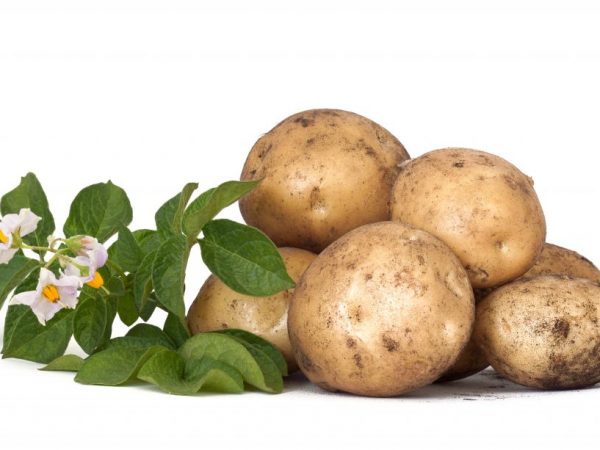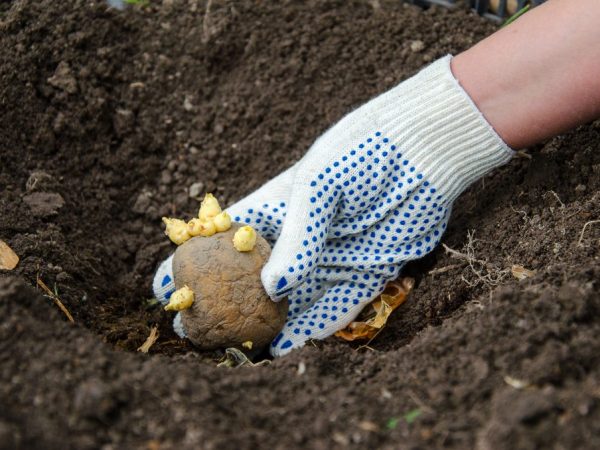Description of Barin potatoes
This potato belongs to the early maturing variety and is considered a table potato. It is often called elite, as its taste and yield are truly impressive. The Barin potato variety is a new development of breeders, but experts are sure that very soon this type of vegetable crop will become very popular among a large number of farmers.

Description of Barin potatoes
Variety characteristic
In the description of the Barin variety, it is said that this species first appeared at the A.G. Lorkh Research Institute in the Moscow Region. Barin's "parent" was the early potato Baron, a native of the Urals, whose characteristics were very popular with breeders, because it is resistant to temperature extremes and diseases.
Barin's peculiarity is that he belongs to early ripening varieties, therefore, after 60-70 days, you can observe the first shoots. Some farmers dig out the harvest ahead of schedule and note that under favorable conditions the Barin is ready for use in 50 days.
Description of the plant
Outwardly, Barin is an erect bush, the branches of which are slightly deviated to the side. The leaves are small and their color is rich.
The slightly wavy edges of the foliage are a characteristic feature of the Barin potato variety. This plant can be called a decoration of the garden, as amazing mauve flowers appear on it. A bush can ripen from 10 to 12 tubers.
Description of the fetus
The emerging potatoes have a creamy beige skin, pale flesh without wateriness, and pinkish eyes. The shape of the potato is oval in color, even, and its weight is from 80 to 120 g.
The resulting crop can be used for a variety of purposes. Potatoes have 15% starch, have a pleasant taste, do not boil over and can be used for frying, boiling and even cooking like fries.
Advantages and disadvantages of the variety
According to the reviews of experienced gardeners and the description, potatoes have many advantages. The characteristics of Barin potatoes are as follows:
- resistance to cancer pathogens and a low probability of its occurrence;
- the variety is practically not affected by the nematode;
- potatoes are perfectly stored, which ensures their high commercial qualities and the possibility of transportation over long distances;
- early ripening;
- the overall yield is quite high.
As for the shortcomings, this is a weak resistance to late blight, as well as common scab. To avoid damage to tubers, it is recommended to take care of prevention in advance, which will avoid the development of diseases.
Soil preparation
In order for the lady potato to be a success, you need to take care of the soil in advance. It is better to prepare the beds in the fall so that the earth receives nutrients and becomes as fertile as possible. To enrich the soil, a mixture of 1 tbsp. tablespoons of sulfate, as well as a glass of ash and a bucket of manure. After that, the soil should be allowed to rest until spring.
A month before the intended planting, you need to prepare seed material.For this, according to the description of experienced gardeners, tubers are selected, the weight of which is not more than 80 g. They can be selected from last year's harvest or purchased in a store. Before planting them, you need to inspect the material for diseases and dents - the potatoes should be smooth and not have visible damage.
Selected tubers must be treated with potassium permanganate. For this, a solution is made of 10 crystals per liter of water. The tubers are allowed to dry, placed in boxes and placed in the light in warm weather (at least 10 degrees). The grown tubers with emerging sprouts are quite ready for planting in the ground.
Planting tubers

The tuber is placed sprouts up
Planting seedlings in the ground should be carried out according to the rules so that the plant can give a good harvest. To do this, follow these steps:
- pits are dug, the depth of which is at least 20 cm: the distance between them should be 50-60 cm so that the plants are not cramped;
- one sprouted tuber is placed in each hole, and strictly sprouts up;
- all seedlings must be densely covered with earth and leveled with a rake;
- it is important to loosen the soil to ensure good air permeability into the holes.
Please note that the choice of planting site must be correct, since the seedlings require warmth and sunlight. It is also necessary to take into account that 15 g of urea or nitrate is required for each m2 in order to enrich the soil.
How to care
Like any plant, Barin potatoes need a number of procedures that help to achieve a good harvest. It should be:
- hilling;
- weeding;
- watering;
- fertilizing with fertilizers.
Despite the fact that many farmers do not consider hilling to be an important procedure, it is still better to carry it out in order to protect plants from diseases. It is enough to huddle the potatoes just twice, and the first time this is done when the shoots reach 15 cm in height, and the second time - after 21 days, and then the soil is loosened with a hoe.
With weeding, there are usually no difficulties, since it is enough just to regularly destroy the weeds so that the Barin receives the necessary moisture and air.
Watering is done in such a way that no water overflow occurs. This potato variety tolerates both moisture and drought well, but you should not overdo it. The formation of a crust on the soil is unacceptable, therefore, in dry and sunny weather, it is advisable to water the potatoes twice a day.
Fertilizers for Barin
As for the nutrition of the soil and its enrichment with minerals and nutrients, then feeding should be done at least 3 times. Before the flowers appear, it is necessary to use urea in the proportions of 1 tbsp. spoon for 10 liters of water. This helps to form healthy stems and shrubs.
The second time to fertilize the seedlings is better during the budding period. Here ash will come to the rescue, which must be used in a concentration of 1 glass per 10 liters of water Art. spoon of superphosphate.
The third feeding is carried out during the period of the appearance of flowers and the formation of tubers. In this case, 1 tbsp is enough. tablespoons of superphosphate per 10 liters of water. Watering with fertilizers is recommended in the morning before the sun appears or in the evening after sunset to avoid burning the leaves.
Disease and pest control
Despite its resistance to many diseases, the Barin variety often becomes a victim of phytophthora. That is why it is necessary to start the fight against the causative agent of the disease in advance, before the appearance of unpleasant symptoms. It is enough to carry out one treatment with "Acrobat", and it will bring positive results.
The plant is also unstable to the "attack" of nematodes and scab, so it is imperative to select high-quality seed material without brown spots, process the tubers with Gumi, Albit or Epin, and also do not forget about processing the site, avoiding weeds, affected shoots, etc.
To protect against the bear and the Colorado potato beetle, it is imperative to use insecticides.For the destruction of the first parasites, Medvetox is suitable, and Antizhuk, Corado and other similar means will stand up to fight against Colorado pests.

